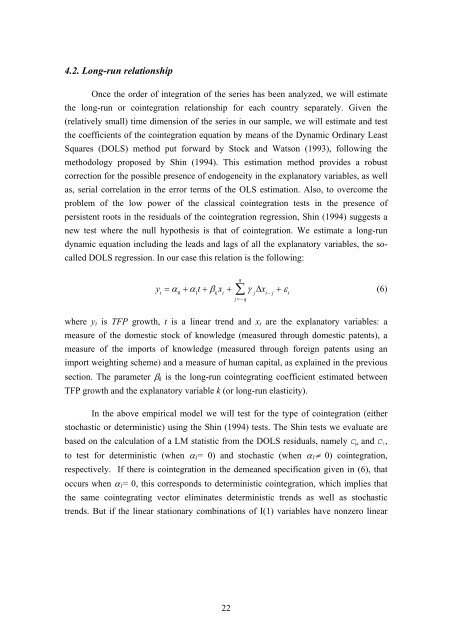You also want an ePaper? Increase the reach of your titles
YUMPU automatically turns print PDFs into web optimized ePapers that Google loves.
4.2. Long-run relationship<br />
Once the order of integration of the series has been analyzed, we will estimate<br />
the long-run or cointegration relationship for each country separately. Given the<br />
(relatively small) time dimension of the series in our sample, we will estimate and test<br />
the coefficients of the cointegration equation by means of the Dynamic Ordinary Least<br />
Squares (DOLS) method put forward by Stock and Watson (1993), following the<br />
methodology proposed by Shin (1994). This estimation method provides a robust<br />
correction for the possible presence of endogeneity in the explanatory variables, as well<br />
as, serial correlation in the error terms of the OLS estimation. Also, to overcome the<br />
problem of the low power of the classical cointegration tests in the presence of<br />
persistent roots in the residuals of the cointegration regression, Shin (1994) suggests a<br />
new test where the null hypothesis is that of cointegration. We estimate a long-run<br />
dynamic equation including the leads and lags of all the explanatory variables, the socalled<br />
DOLS regression. In our case this relation is the following:<br />
y t<br />
= α 0<br />
+ α 1<br />
t + β k<br />
x t<br />
+<br />
q<br />
γ j<br />
j=−q<br />
∑ Δx t − j<br />
+ ε t<br />
(6)<br />
where y t is TFP growth, t is a linear trend and x t are the explanatory variables: a<br />
measure of the domestic stock of knowledge (measured through domestic patents), a<br />
measure of the imports of knowledge (measured through foreign patents using an<br />
import weighting scheme) and a measure of human capital, as explained in the previous<br />
section. The parameter β k is the long-run cointegrating coefficient estimated between<br />
TFP growth and the explanatory variable k (or long-run elasticity).<br />
In the above empirical model we will test for the type of cointegration (either<br />
stochastic or deterministic) using the Shin (1994) tests. The Shin tests we evaluate are<br />
based on the calculation of a LM statistic from the DOLS residuals, namely C μ and C τ ,<br />
to test for deterministic (when α 1 = 0) and stochastic (when α 1 ≠ 0) cointegration,<br />
respectively. If there is cointegration in the demeaned specification given in (6), that<br />
occurs when α 1 = 0, this corresponds to deterministic cointegration, which implies that<br />
the same cointegrating vector eliminates deterministic trends as well as stochastic<br />
trends. But if the linear stationary combinations of I(1) variables have nonzero linear<br />
22

















